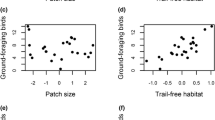Abstract
Practically no information exists on the impact of human trampling on tropical rain forest vegetation. We studied three trails with varying periods of use and recovery in a tropical rain forest in Costa Rica. Human impact on trailside plants was curvilinearly related to use, as found by other workers in temperate zone vegetation. Recovery in a period of two years and eight months had been rapid, and herbs and seedlings were more abundant along the recovering trail than in undisturbed forest. The results imply that a shifting mosaic of trails, analogous to the mosaic created by light gaps, may be the best management technique to minimize the impact of human visitors in tropical rain forests.
Similar content being viewed by others
Literature Cited
Cole, D. N. 1986. Recreation impacts on backcountry campsites in Grand Canyon National Park, Arizona, USA.Environmental Management 10:651–659.
Cole, D. N. 1987. Effects of three seasons of experimental trampling on five montane forest communities and a grassland in western Montana, USA.Biological Conservation 40:219–244.
Cole, D. N., and J. L. Marion. 1988. Recreation impacts in some riparian forests of the eastern United States.Environmental Management 12:99–107.
Cole, D. N., and E. G. S. Schreiner. 1981. Impacts of back-country recreation: Site management and rehabilitation—an annotated bibliography. USDA-Forest Service Intermountain Forest and Range. Experiment Station, General Technical Report INT-121.
Denslow, J. S. 1987. Tropical rainforest gaps and tree species diversity.Annual Review of Ecology and Systematics 18:431–451.
Gentry, A. H., and C. Dodson. 1987. Contribution of nontrees to species richness of a tropical rain forest.Biotropica 19:149–156.
Gomez, L. D. 1985. Vegetación de Costa Rica. Editorial UNED. San Jose, Costa Rica.
Jim, C. Y. 1987. Trampling impacts of recreationists on picnic sites in a Hong Kong country park.Environmental Conservation 14:117–127.
Kuss, F. R. 1986. A review of major factors influencing plant responses to recreation impacts.Environmental Management 10:637–650.
Kuss, F. R., and A. R. Graefe. 1985. Effects of recreation trampling on natural area vegetation.Journal of Leisure Research 17:165–183.
Liddle, M. J. 1975. A theoretical relationship between the primary productivity of vegetation and its ability to tolerate trampling.Biological Conservation 8:251–255.
Liddle, M. J., and N. C. Thyer. 1986. Trampling and fire in a subtropical dry sclerophyll forest.Environmental Conservation 13:33–39.
Little, T. M., and F. J. Hills. 1978. Agricultural experimentation: Design and analysis. John Wiley & Sons, New York.
Smith, A. P. 1987. Respuestas de hierbas del sotobosque tropical a claros ocasionados por la caída de árboles. Pages 111–118in D. A. Clark, R. Dirzo, and N. Fetcher (eds.), Ecología y ecofisiología de plantas en los bosques mesoamericanos.Revista de Biología Tropical 35:supplement 1.
Sokal, R. R., and F. J. Rohlf. 1981. Biometry, 2nd ed. W. H. Freeman, San Francisco.
Author information
Authors and Affiliations
Rights and permissions
About this article
Cite this article
Boucher, D.H., Aviles, J., Chepote, R. et al. Recovery of trailside vegetation from trampling in a tropical rain forest. Environmental Management 15, 257–262 (1991). https://doi.org/10.1007/BF02393857
Issue Date:
DOI: https://doi.org/10.1007/BF02393857




